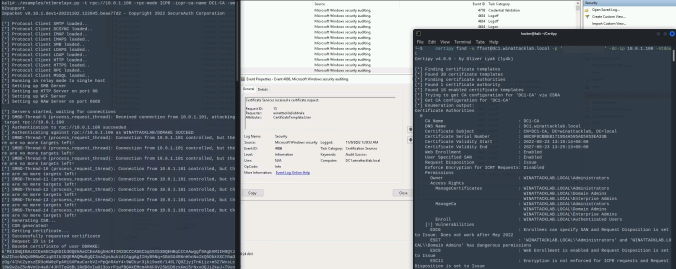NTLM is the legacy authentication protocol in Windows environment. In the past few years, I’ve had the opportunity to write on this blog about NTLM Relaying to DCOM (twice), to AD CS (ESC11) and to MSSQL. Today I will look back on relaying to HTTPS and how the tooling improved.
Compass Security Blog
Offensive Defense
Kerberos is the default authentication protocol in on-prem Windows environments. We’re launching a 6-part YouTube series, a technical deep dive into Kerberos. We’ll break down the protocol, dissect well-known attacks, and cover defensive strategies to keep your environment secure.
Introducing a certipy parse command to perform stealthy offline AD CS enumeration based on local registry data.
This blog post introduces our new custom queries for BloodHound Community Edition (CE) and explains how you can use them effectively to analyze your Active Directory infrastructure. TL;DR: Check out our new BloodHound CE custom queries! Active Directory and BloodHound The majority of our customers run a Microsoft Active Directory infrastructure, either exclusively on-prem or […]
In June last year, the good folks at SpecterOps dropped awesome research on Active Directory Certificate Services (AD CS) misconfigurations. Since then, we find and report these critical vulnerabilities at our customers regularly. One of these new attack path is relaying NTLM authentication to unprotected HTTP endpoints. This allows an attacker to get a valid […]
Passwordless products promise greater security and convenience by allowing users to log in to Windows systems with only their smartphone. But what is going on behind the scenes and how could a domain’s security stance be worsened by such a solution? In this post I will explain how these products are implemented and detail the vulnerabilities and weaknesses discovered in three tested products.
During internal assessments in Windows environments, we use BloodHound more and more to gather a comprehensive view of the permissions granted to the different Active Directory objects. In this post, we’ll show an advanced usage of this tool by using our additional queries.
When you add a new computer, it must first join the domain. If you use its future main user to do it, they’ll become the owner and be able to hijack the computer to become a local administrator in four easy steps.
As a defender, you want to find and patch attack paths in your Active Directory environment. One cannot easily spot issues by looking at the Active Directory Users and Computers console, GPOs, etc. but here comes BLOODHOUND.
In this last article about privilege escalation in Windows domains, we demonstrate how to extract credentials from running systems to compromise high-privileged accounts.
© 2025 Compass Security Blog








